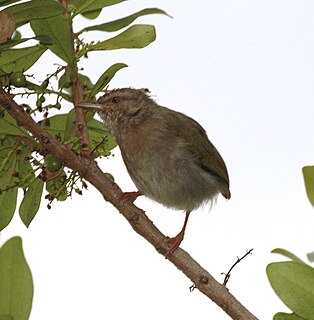Old World warblers are a large group of birds formerly grouped together in the bird family Sylviidae. The family held over 400 species in over 70 genera, and were the source of much taxonomic confusion. Two families were split out initially, the cisticolas into Cisticolidae and the kinglets into Regulidae. In the past ten years they have been the subject of much research and many species are now placed into other families, including the Acrocephalidae, Cettiidae, Phylloscopidae, and Megaluridae. In addition some species have been moved into existing families or have not yet had their placement fully resolved. A smaller family of warblers, together with some babblers formerly placed in the family Timaliidae and the parrotbills, are retained in a much smaller family Sylviidae.

The white-crowned sparrow is a species of passerine bird native to North America. A medium-sized member of the New World sparrow family, this species is marked by a grey face and black and white streaking on the upper head. It breeds in brushy areas in the taiga and tundra of the northernmost parts of the continent and in the Rocky Mountains and Pacific coast. While southerly populations in the Rocky Mountains and coast are largely resident, the breeding populations of the northerly part of its range are migratory and can be found as wintering or passage visitors through most of North America south to central Mexico.

The long-billed crombec or Cape crombec is an African warbler.

The northern crombec is a species of African warbler, formerly placed in the family Sylviidae. It is found in Benin, Burkina Faso, Cameroon, Central African Republic, Chad, Democratic Republic of the Congo, Ivory Coast, Djibouti, Eritrea, Ethiopia, Gambia, Ghana, Guinea, Guinea-Bissau, Kenya, Mali, Mauritania, Niger, Nigeria, Senegal, Sierra Leone, Somalia, Sudan, Tanzania, Togo, and Uganda. Its natural habitat is dry savanna.

Sylvietta, the crombecs, is a genus of African warblers. Formerly placed in the massively paraphyletic Sylviidae, it is now considered to belong to a newly recognized family found only in Africa, Macrosphenidae.
Chapin's crombec is an enigmatic African warbler, formerly placed in the family Sylviidae. It is currently considered a subspecies of the white-browed crombec, but might be a distinct species; too little is known about it to determine this now with reasonable certainty.

The lemon-bellied crombec is a species of African warbler, formerly placed in the family Sylviidae. It is sparsely present throughout the African tropical rainforest. Its natural habitats are subtropical or tropical moist lowland forests and subtropical or tropical moist shrubland.
The Somali crombec is a species of African warbler, formerly placed in the family Sylviidae. It is found in Ethiopia, Kenya, Somalia, and Tanzania. Its natural habitat is subtropical or tropical dry shrubland.

Philippa's crombec, also known as the short-billed crombec, is a species of African warbler, formerly placed in the family Sylviidae. It is found in Ethiopia and Somalia. Its natural habitat is dry savanna.

The red-capped crombec is a species of African warbler, formerly placed in the family Sylviidae.

The green crombec is a species of African warbler, formerly placed in the family Sylviidae. It is widespread across the African tropical rainforest. Its natural habitats are subtropical or tropical moist lowland forests and subtropical or tropical moist shrubland.

The red-faced crombec is a species of African warbler, formerly placed in the family Sylviidae. It is found in Burundi, Ethiopia, Kenya, Malawi, Mozambique, Namibia, Rwanda, South Sudan, Tanzania, Uganda, and Zimbabwe. Its natural habitats are subtropical or tropical dry forests, subtropical or tropical moist montane forests, and subtropical or tropical dry shrubland.

The white-browed scrub robin, also known as the red-backed scrub-robin, is a species of bird in the family Muscicapidae. It is native to sub-Saharan Africa, especially East and southern Africa. Within range, its Turdus-like song is one of the often-heard sounds of the bush. The flitting of the tail is characteristic of this species, but also of some near relatives.

The white-browed antbird is a species of perching bird in the family Thamnophilidae. It is found in Bolivia, Brazil, Colombia, Ecuador, French Guiana, Guyana, Peru, Suriname, and Venezuela. Its natural habitats are subtropical or tropical moist lowland forests and subtropical or tropical moist montane forests.

The white-browed chat-tyrant is a species of bird in the family Tyrannidae. It is found in the Puna grassland.

The African warblers are a newly erected family Macrosphenidae, of songbirds. Most of the species were formerly placed in the Old World warbler family Sylviidae, although one species, the rockrunner, was placed in the babbler family, Timaliidae. A series of molecular studies of the Old World warblers and other bird families in the superfamily Sylvioidea found that the African warblers were not part of Sylviidae but were instead an early (basal) offshoot of the entire clade Sylvioidea. Some taxonomic authorities place the entire family Hyliidae here.













